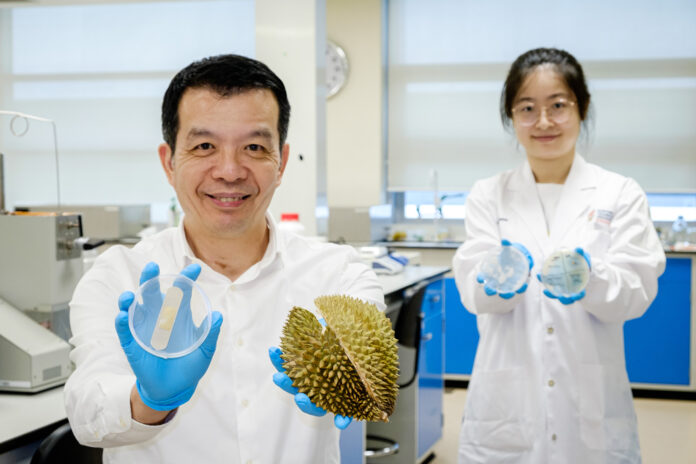
With the world adopting new policies towards reducing industrial waste and producing less plastic, scientists are now looking at ways to create products using recycled and upcycled materials.
One such interesting product has come out of Singapore’s Nanyang Technological University, where Professor William Chen and his team from the School of Chemical and Biomedical Engineering have created an antimicrobial bandage using the husk of a fruit called Durian.
Durians exist in abundance in South East Asia where they are known as the “King of fruits”. While the fruit inside is edible, the thick husk on the outside is not and usually goes to the incinerator. However, the researchers from NTU decided that this was a wasteful practice.
Instead, they freeze-dried the husks and extracted cellulose, a component of plant cell walls, from them. They combined cellulose with another waste material, glycerol, which is the by-product of soap and biodiesel production. The process yielded a soft hydrogel material which they cut into strips for bandages.
Hydrogel bandages
Hydrogel bandages are not a new invention. Doctors prefer to use them to cover surgical sites to promote good healing since these patches provide coolness and moisture to the wound instead of drying them out as conventional gauze bandages do.
However, the usual hydrogels use synthetic materials and get their antimicrobial properties from expensive silver or copper ions.
Comparatively, the durian hydrogel uses a much cheaper and sustainable agent found abundantly in nature: yeast. Taking baker’s yeast, the team extracted a compound called natural yeast phenolic. This has antimicrobial properties, especially against E. coli and S. aureus.
According to Prof. Chen:
“With the growing threat of antibiotic-resistant superbugs, the world will need multiple alternative ways to prevent infections. An effective way to protect open wounds is with antimicrobial bandages that are biocompatible and safe for prolonged use by humans. This is especially important for diabetic patients suffering from chronic wounds.
The team tested these bandages in the lab to dress wounds on animal skins and found that they prevented microbial growth even at -30 degrees Celsius. They published these findings in ACS Sustainable Chemistry & Engineering.
The hydrogel is actually Prof. Chen’s newest attempt at recycling food waste. Previously, his team published a paper in Scientific Reports that showed how cellulose from soybean pulp could be used to make wearable electronics to detect vital signs.
Source: Nanyang Technological University
https://www.ntu.edu.sg/docs/default-source/corporate-ntu/hub-news/ntu-singapore-scientists-develop-antibacterial-gel-bandage-using-durian-husk-06cc9a43-3921-491e-861c-d7d911e2cc4d.pdf?sfvrsn=94c13236_3



